Do you have a question about the Komatsu PC16R-3HS and is the answer not in the manual?
Describes the importance and location of safety plates on the machine.
Explains the meaning of various pictograms used on machine safety labels.
Emphasizes using only trained staff and following all safety rules.
Instructs on reporting and handling machine anomalies or malfunctions.
Stresses the importance of maintaining safety devices and guards in good condition.
Details necessary personal protective equipment (PPE) and appropriate attire.
Details precautions to prevent fires related to fuel and oil handling.
Instructs to remove flammable materials from the engine area to prevent fires.
Provides steps to take in the event of a fire on the machine.
Explains the function of ROPS (Rollover Protection System) and precautions.
Covers checks for ground conditions, utilities, and work area safety before starting.
Details steps to prevent fires, including removing flammables and checking for leaks.
Details pre-start checks, seat belt use, and horn signaling.
Details safe practices for operating on slopes, including speed and direction.
Advises against turret swing on slopes and suggests creating platforms.
Highlights risks associated with machine overturns or ground collapse.
Warns about the extreme danger of overhead electric lines and minimum safety distances.
Details the procedure for safely parking the machine on level ground or slopes.
Details hazards associated with battery acid, hydrogen gas, and handling precautions.
Provides instructions and safety precautions for jump-starting the machine.
Emphasizes ensuring machine stability during dismantling or assembly.
Details crucial safety steps for working beneath the machine.
Highlights the importance of periodic replacement of safety-critical parts.
Reinforces the need for machine stability during maintenance procedures.
Stresses stopping the engine before any maintenance or inspection.
Lists specific situations requiring the battery main switch to be turned OFF.
Provides critical safety rules for refueling and adding oil to prevent fires.
Covers safety measures when working with the battery and alternator.
Details dangers of high-pressure oil leaks and protective measures.
Warns about risks associated with hot components and pressurized systems during maintenance.
Highlights explosion risks from hydraulic accumulators and necessary precautions.
Explains the function and meaning of warning lights and gauges on the instrument panel.
Provides an overview of control levers and pedals for machine operation.
Explains the safety lever's function in locking work equipment and preventing accidental movement.
Details the left and right control levers for arm, turret, boom, and bucket.
Explains the operation of travel levers for forward, reverse, and steering.
Covers essential visual checks before starting the engine.
Lists daily inspection points for work equipment, engine, undercarriage, etc.
Details daily checks for coolant, oil, fuel, filters, and wiring systems.
Provides instructions for starting the engine in warm conditions.
Outlines the steps for starting the engine under normal temperature conditions.
Details specific procedures and precautions for starting the engine in cold weather.
Covers post-start procedures and warnings.
Provides instructions for safely shutting down the engine.
Provides guidance on basic machine movement, including pre-movement checks.
Lists essential steps before moving the machine, including accelerator and safety lever.
Details how to move the machine forward using travel levers and speed selection.
Explains how to move the machine in reverse, including sprocket position.
Provides instructions for safely stopping the machine's movement.
Explains how to steer the machine using travel levers.
Explains how to steer the machine using travel levers, including counter-rotations.
Provides instructions for safely swinging the machine's turret.
Details the operation of arm, swing, boom, and bucket controls.
Warns against using turret swing force for compacting or breaking.
Prohibits using travel force for digging operations, which can damage the machine.
Prohibits using bucket dropping force as a pickaxe or breaker.
Discourages using machine's gravity for digging operations.
Details safe practices for operating on slopes, including speed and direction.
Provides steps for extracting the machine when one track is stuck in mud.
Details the procedure for safely parking the machine on level ground or slopes.
Details checks after stopping the engine, including leakages and cleaning.
Details safety precautions and procedures for loading and unloading.
Explains how to secure the machine for transport using anchorage points and tie-downs.
Provides specifications for engine oil, hydraulic oil, fuel, and coolant.
Lists safety-related components requiring periodic inspection and change.
Details maintenance tasks based on operating hours and required intervals.
Lists maintenance tasks to be performed as needed.
Details checks to perform daily before starting the engine.
Details tasks for 500-hour maintenance intervals.
Lists tasks for 1000-hour maintenance intervals.
Outlines tasks for 2000-hour maintenance intervals.
Lists procedures for tasks like air filter checks, battery checks, and fuel draining.
Provides detailed steps for checking, cleaning, or replacing the air filter cartridge.
Provides procedures for checking and adjusting rubber track tension.
Explains the procedure for bleeding the hydraulic system after maintenance.
Lists essential checks before starting the engine, including fluid levels and systems.
Covers tasks for 500-hour intervals, including oil and filter changes.
Provides detailed steps for changing engine oil and filter.
Details the procedure for changing the fuel filter and bleeding the circuit.
Outlines tasks for 1000-hour maintenance intervals.
Outlines tasks for 2000-hour maintenance intervals.
Advises consulting the distributor for proper attachment selection and safety checks.
Details safety precautions for removing or installing attachments.
Covers safety measures when using attachments, especially heavy ones or on angles.
Explains the work equipment control levers and associated safety precautions.
Provides guidance on operating attachments like the hammer.
Provides precautions and operating instructions for using a hydraulic hammer.
Explains how to unlock and lock the bucket or accessory using the quick coupler.
Guides on operating the hydraulic breaker using the equipment control pedal.
Lists precautions for using the breaker, including selection valve and accelerator settings.
Details main applications and precautions for using a hydraulic breaker.
Lists incorrect operations to avoid for long machine life and safety.
Prohibits fully extending cylinders to lift the machine due to potential damage.
Describes the importance and location of safety plates on the machine.
Explains the meaning of various pictograms used on machine safety labels.
Emphasizes using only trained staff and following all safety rules.
Instructs on reporting and handling machine anomalies or malfunctions.
Stresses the importance of maintaining safety devices and guards in good condition.
Details necessary personal protective equipment (PPE) and appropriate attire.
Details precautions to prevent fires related to fuel and oil handling.
Instructs to remove flammable materials from the engine area to prevent fires.
Provides steps to take in the event of a fire on the machine.
Explains the function of ROPS (Rollover Protection System) and precautions.
Covers checks for ground conditions, utilities, and work area safety before starting.
Details steps to prevent fires, including removing flammables and checking for leaks.
Details pre-start checks, seat belt use, and horn signaling.
Details safe practices for operating on slopes, including speed and direction.
Advises against turret swing on slopes and suggests creating platforms.
Highlights risks associated with machine overturns or ground collapse.
Warns about the extreme danger of overhead electric lines and minimum safety distances.
Details the procedure for safely parking the machine on level ground or slopes.
Details hazards associated with battery acid, hydrogen gas, and handling precautions.
Provides instructions and safety precautions for jump-starting the machine.
Emphasizes ensuring machine stability during dismantling or assembly.
Details crucial safety steps for working beneath the machine.
Highlights the importance of periodic replacement of safety-critical parts.
Reinforces the need for machine stability during maintenance procedures.
Stresses stopping the engine before any maintenance or inspection.
Lists specific situations requiring the battery main switch to be turned OFF.
Provides critical safety rules for refueling and adding oil to prevent fires.
Covers safety measures when working with the battery and alternator.
Details dangers of high-pressure oil leaks and protective measures.
Warns about risks associated with hot components and pressurized systems during maintenance.
Highlights explosion risks from hydraulic accumulators and necessary precautions.
Explains the function and meaning of warning lights and gauges on the instrument panel.
Provides an overview of control levers and pedals for machine operation.
Explains the safety lever's function in locking work equipment and preventing accidental movement.
Details the left and right control levers for arm, turret, boom, and bucket.
Explains the operation of travel levers for forward, reverse, and steering.
Covers essential visual checks before starting the engine.
Lists daily inspection points for work equipment, engine, undercarriage, etc.
Details daily checks for coolant, oil, fuel, filters, and wiring systems.
Provides instructions for starting the engine in warm conditions.
Outlines the steps for starting the engine under normal temperature conditions.
Details specific procedures and precautions for starting the engine in cold weather.
Covers post-start procedures and warnings.
Provides instructions for safely shutting down the engine.
Provides guidance on basic machine movement, including pre-movement checks.
Lists essential steps before moving the machine, including accelerator and safety lever.
Details how to move the machine forward using travel levers and speed selection.
Explains how to move the machine in reverse, including sprocket position.
Provides instructions for safely stopping the machine's movement.
Explains how to steer the machine using travel levers.
Explains how to steer the machine using travel levers, including counter-rotations.
Provides instructions for safely swinging the machine's turret.
Details the operation of arm, swing, boom, and bucket controls.
Warns against using turret swing force for compacting or breaking.
Prohibits using travel force for digging operations, which can damage the machine.
Prohibits using bucket dropping force as a pickaxe or breaker.
Discourages using machine's gravity for digging operations.
Details safe practices for operating on slopes, including speed and direction.
Provides steps for extracting the machine when one track is stuck in mud.
Details the procedure for safely parking the machine on level ground or slopes.
Details checks after stopping the engine, including leakages and cleaning.
Details safety precautions and procedures for loading and unloading.
Explains how to secure the machine for transport using anchorage points and tie-downs.
Provides specifications for engine oil, hydraulic oil, fuel, and coolant.
Lists safety-related components requiring periodic inspection and change.
Details maintenance tasks based on operating hours and required intervals.
Lists maintenance tasks to be performed as needed.
Details checks to perform daily before starting the engine.
Details tasks for 500-hour maintenance intervals.
Lists tasks for 1000-hour maintenance intervals.
Outlines tasks for 2000-hour maintenance intervals.
Lists procedures for tasks like air filter checks, battery checks, and fuel draining.
Provides detailed steps for checking, cleaning, or replacing the air filter cartridge.
Provides procedures for checking and adjusting rubber track tension.
Explains the procedure for bleeding the hydraulic system after maintenance.
Lists essential checks before starting the engine, including fluid levels and systems.
Covers tasks for 500-hour intervals, including oil and filter changes.
Provides detailed steps for changing engine oil and filter.
Details the procedure for changing the fuel filter and bleeding the circuit.
Outlines tasks for 1000-hour maintenance intervals.
Outlines tasks for 2000-hour maintenance intervals.
Advises consulting the distributor for proper attachment selection and safety checks.
Details safety precautions for removing or installing attachments.
Covers safety measures when using attachments, especially heavy ones or on angles.
Explains the work equipment control levers and associated safety precautions.
Provides guidance on operating attachments like the hammer.
Provides precautions and operating instructions for using a hydraulic hammer.
Explains how to unlock and lock the bucket or accessory using the quick coupler.
Guides on operating the hydraulic breaker using the equipment control pedal.
Lists precautions for using the breaker, including selection valve and accelerator settings.
Details main applications and precautions for using a hydraulic breaker.
Lists incorrect operations to avoid for long machine life and safety.
Prohibits fully extending cylinders to lift the machine due to potential damage.
| Brand | Komatsu |
|---|---|
| Model | PC16R-3HS |
| Category | Excavators |
| Language | English |
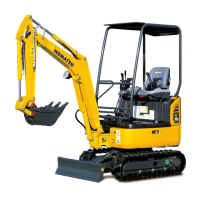
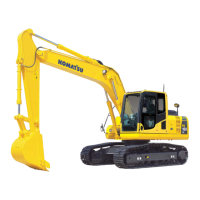
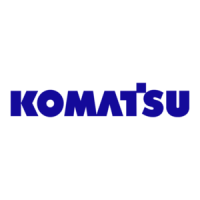
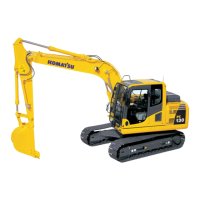

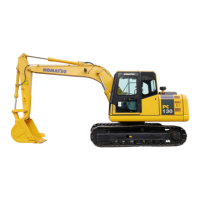

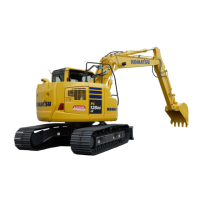
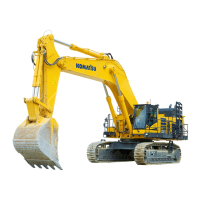
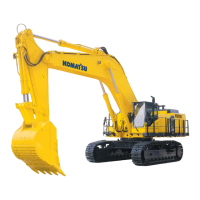
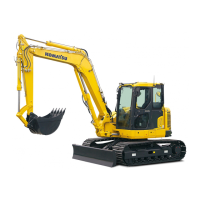

